Imagine placing your own homemade sushi ginger next to your beautifully crafted sushi rolls.
Your guests taste the crisp slices, eyebrows raised in surprise, recognizing the authentic quality usually reserved for restaurants.
Store-bought gari often tastes flat and overly processed, lacking the bright complexity that makes this condiment essential to Japanese cuisine. I actually compared them directly, and honestly, the gap was like night and day.

My traditional method uses only pure, natural ingredients to create gari that’s both beautiful and clean-tasting. Ready to discover how simple ingredients can create something extraordinary?
What is Sushi Ginger?
Sushi ginger, known as gari (ガリ), is thinly sliced young ginger pickled in sweet vinegar, traditionally served alongside sushi. The name “gari” mimics the crunchy “gari-gari” sound heard when slicing or biting into ginger.
This isn’t just a garnish; it serves three crucial functions:
- It’s consumed between different types of sushi to refresh the taste buds, preparing them for the next flavor. This practice is particularly important when transitioning from rich, bold-flavored sushi (e.g., ikura) to a more delicate one (e.g., white fish).
- Gari also serves an etiquette function. Use it as a brush to apply soy sauce to delicate sushi like gunkanmaki without disturbing the toppings.
- During the Edo period (1603 – 1868), without refrigeration, these antimicrobial compounds provided essential food safety for raw fish.
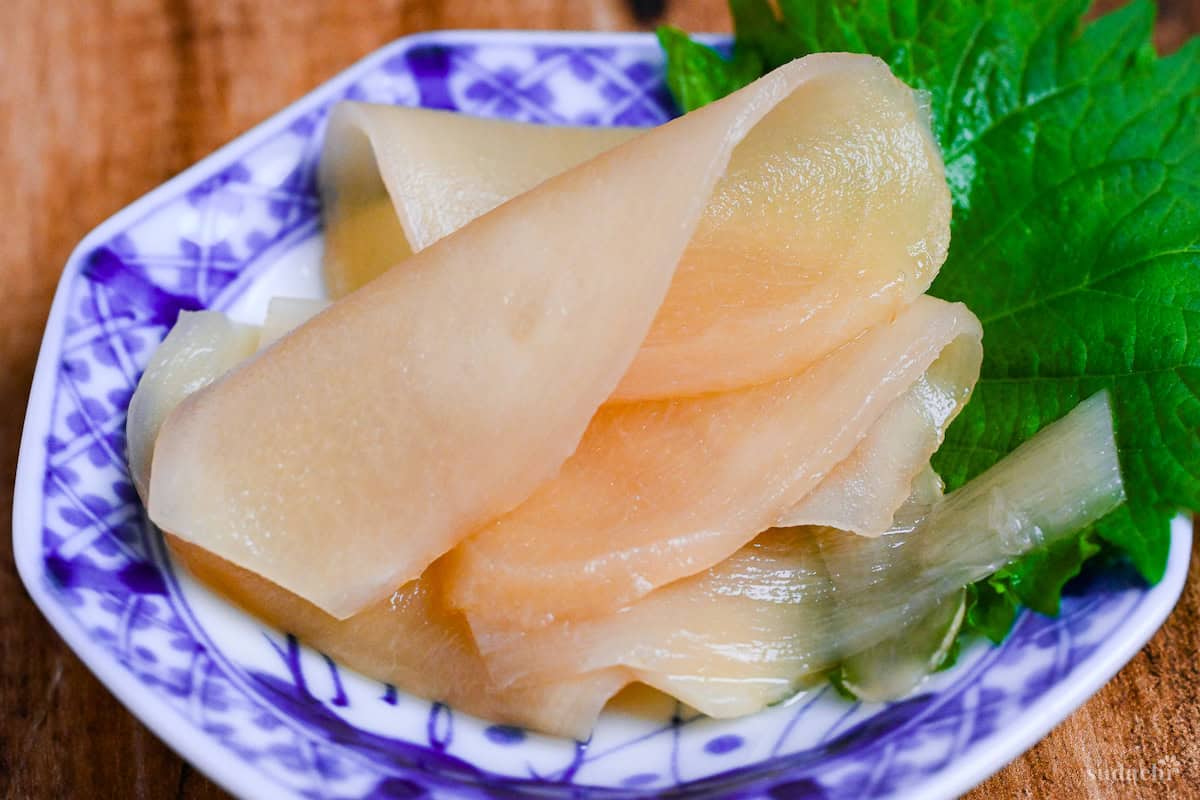
In Japan, the best time to enjoy homemade gari is in June and July, when young ginger is in season.
Key Ingredients & Substitution Ideas
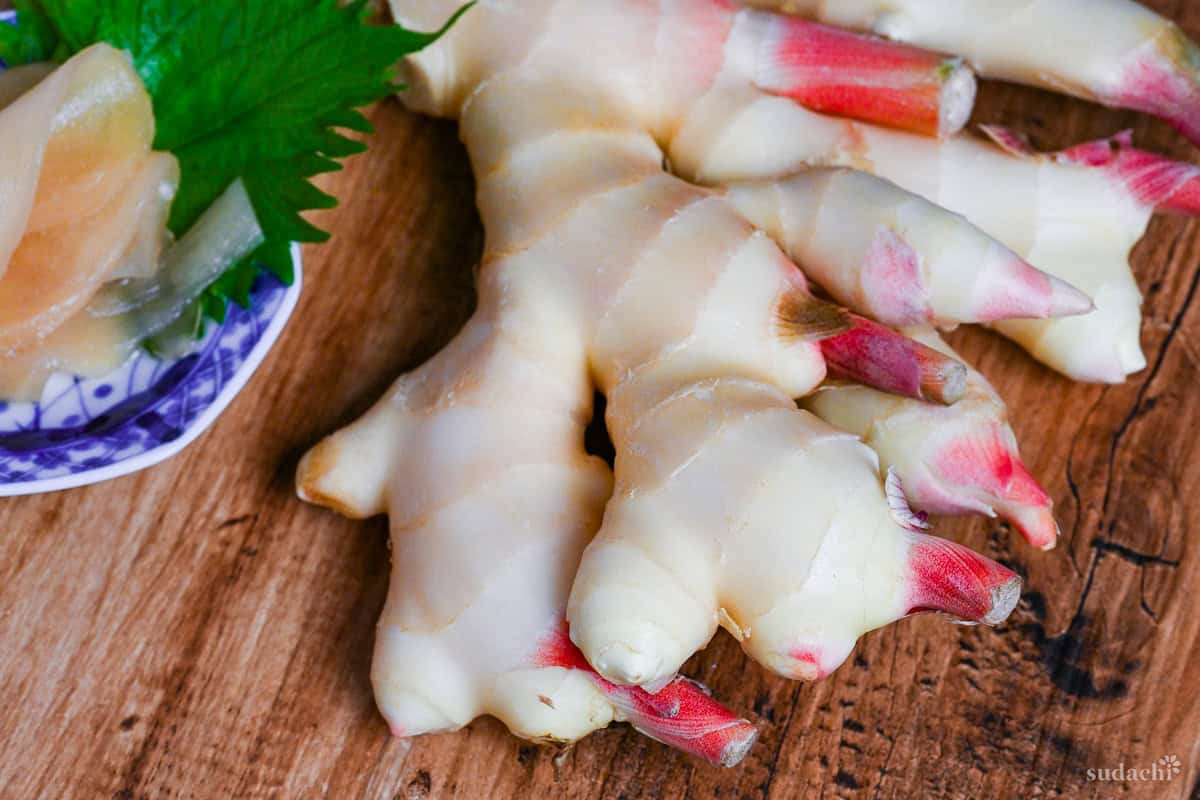
- Young Ginger (New Ginger): Choose fresh young ginger, also known as new ginger, which is harvested in early summer. It’s softer, milder, and has thinner skin than regular (mature) ginger, making it ideal for pickling into sushi ginger.
- Rice Vinegar: I prefer rice vinegar for its mild flavor and authentic taste. If you don’t have rice vinegar on hand, grain vinegar or plain white vinegar are good alternatives.
- Light Brown Sugar: It is my personal go-to because its subtle molasses flavor gives a richer depth to the pickled ginger. If unavailable, plain white sugar works perfectly fine.
Can You Make Gari with Regular (Mature) Ginger?
Let’s be honest, authentic gari absolutely shines when made with young ginger. But I understand that finding young ginger outside of Japan can be impossible.
The good news is… you can make tasty gari with regular mature ginger, but you’ll have to tweak your method a bit to deal with its stronger personality.
| Feature | Young Ginger | Regular Ginger | What It Means for Gari |
|---|---|---|---|
| Skin & Fibers | Paper-thin skin, fine fibers | Thick skin, tough fibers | Needs deeper peeling and ultra-thin slicing to avoid stringiness |
| Heat Level | Gentle, aromatic warmth | Sharper, lingering bite | Must temper the heat |
| Natural Pink Hue | Contains anthocyanins → blush-pink in vinegar | Virtually no anthocyanins | The result stays pale yellow |
| Water Content | Juicy, crisp | Drier, denser | Longer brining/soaking needed |
| Typical Size | Small knobs | Large, chunky roots | Target the tender core, trim away woody edges |
If you want to make gari with regular ginger, consider doing the below:
- Smart cutting techniques – Choose the center portions of your ginger root where possible, as these tend to be less fibrous than the outer edges. Use a vegetable peeler to create paper-thin shavings rather than knife slices. The thinner you can go, the better your final texture will be.
- Intensity management – Regular ginger’s sharper bite requires a more thorough mellowing process. After slicing, give it a generous salt massage. Follow this with pouring boiling water over the salted ginger and let it sit for 2-3 minutes before draining.
- Setting expectations – Here’s the trade-off you’ll need to accept: your gari won’t develop that characteristic pale pink blush. Regular ginger lacks the anthocyanin pigments found in young ginger’s pink stems, so your finished product will remain cream-colored. Also, there’s no denying that the texture and pungency are still going to be different from young ginger ones.
- Authenticity vs. Accessibility: Yes, true sushi restaurants gari is made of young ginger, but mature roots + smart prep = 70 – 80 % of the experience.
- Texture First, Color Second: Ultra-thin slicing and brief blanching beat any food dye.
- Flavor Control Is Yours: Adjust sweetness, acidity, and tint to suit your palate.
Visual Walkthrough & Tips
Here are my step-by-step instructions for how to make Sushi Ginger at home. For ingredient quantities and simplified instructions, scroll down for the Printable Recipe Card below.
If you prefer to watch the process in action, check out my YouTube video of this gari recipe for a complete visual walkthrough!
Start by combining water, rice vinegar, light brown sugar (or regular sugar), soy sauce, and kombu in a saucepan. Heat the mixture over medium heat until it just begins to bubble around the edges. You want it almost at a boil, but not quite there.
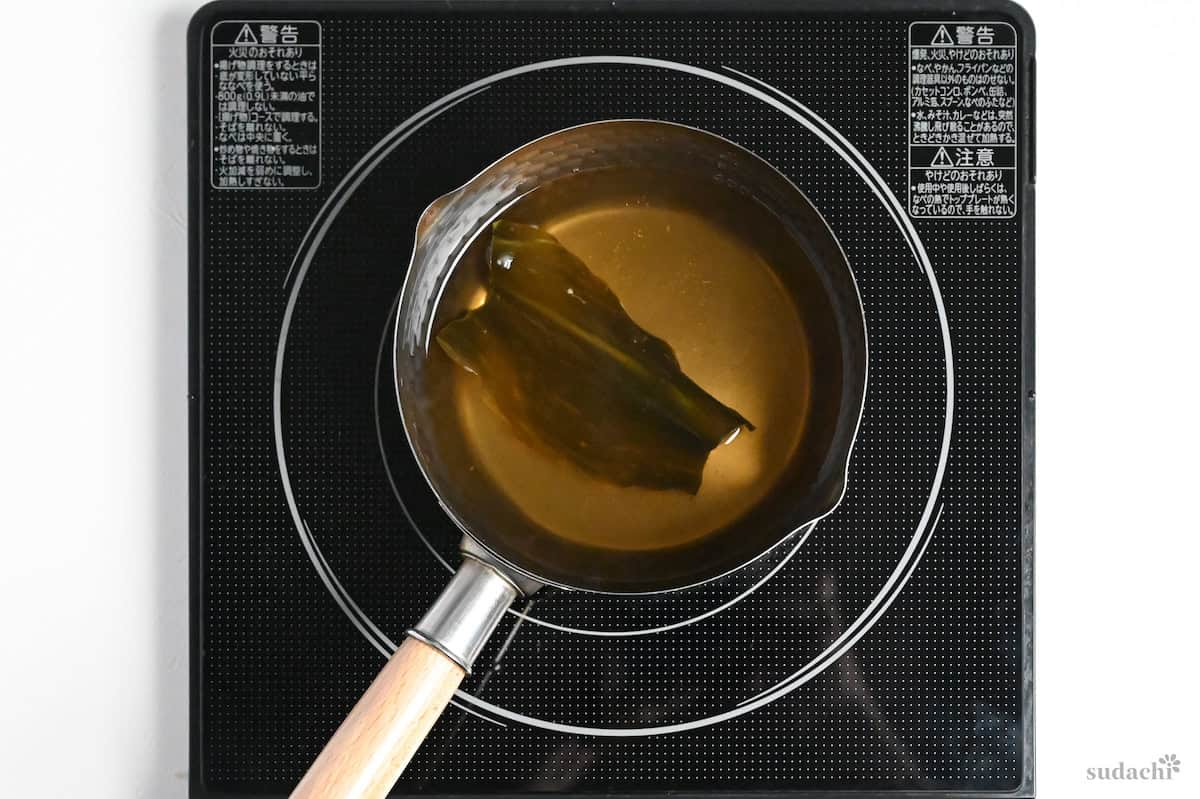
Turn off the heat immediately and let the pickling liquid cool completely to room temperature.
Kombu adds subtle umami notes to the pickling liquid, enhancing the overall flavor. Be sure not to boil it vigorously, as this can release bitter compounds and can make the liquid slimy.
While your pickling liquid cools, cut the young ginger (also known as new ginger) into manageable sections about 5cm (about 2 inches) long.
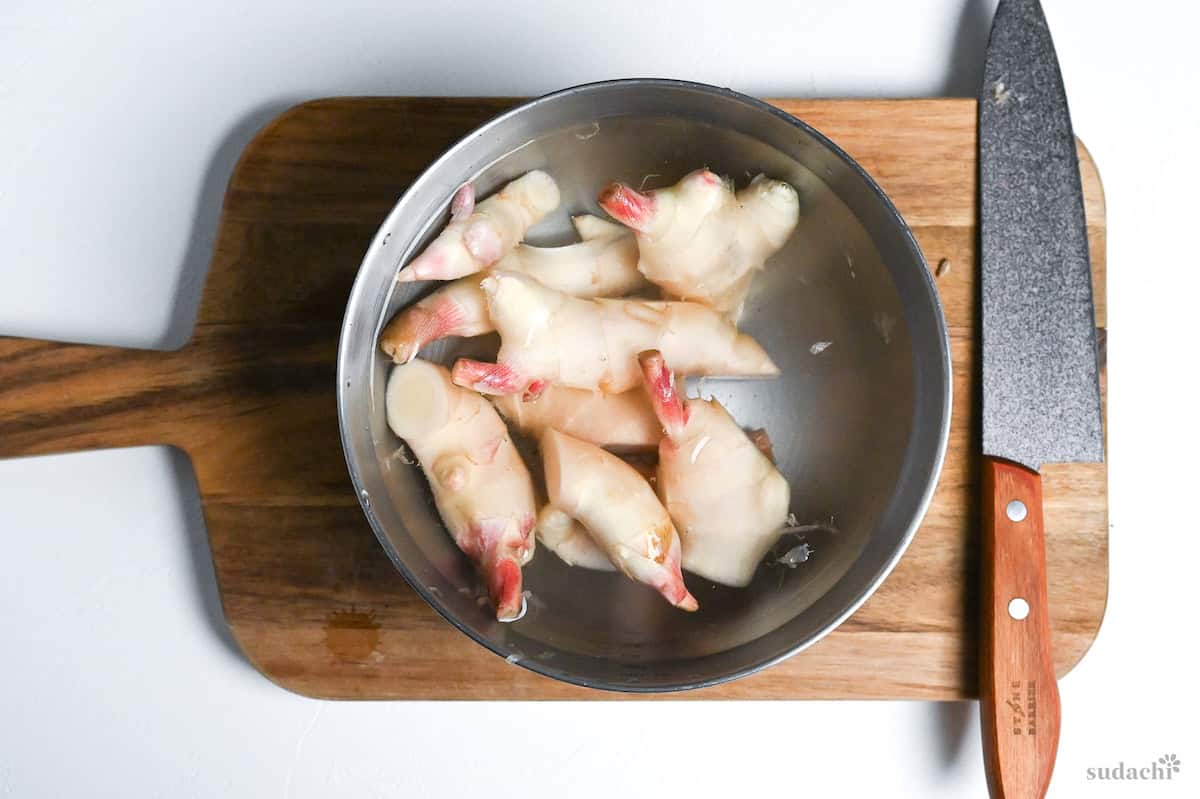
Soak these briefly in water and thoroughly rub to remove any dirt, paying attention to crevices. Scrape away any brown or dirty spots gently with a spoon.
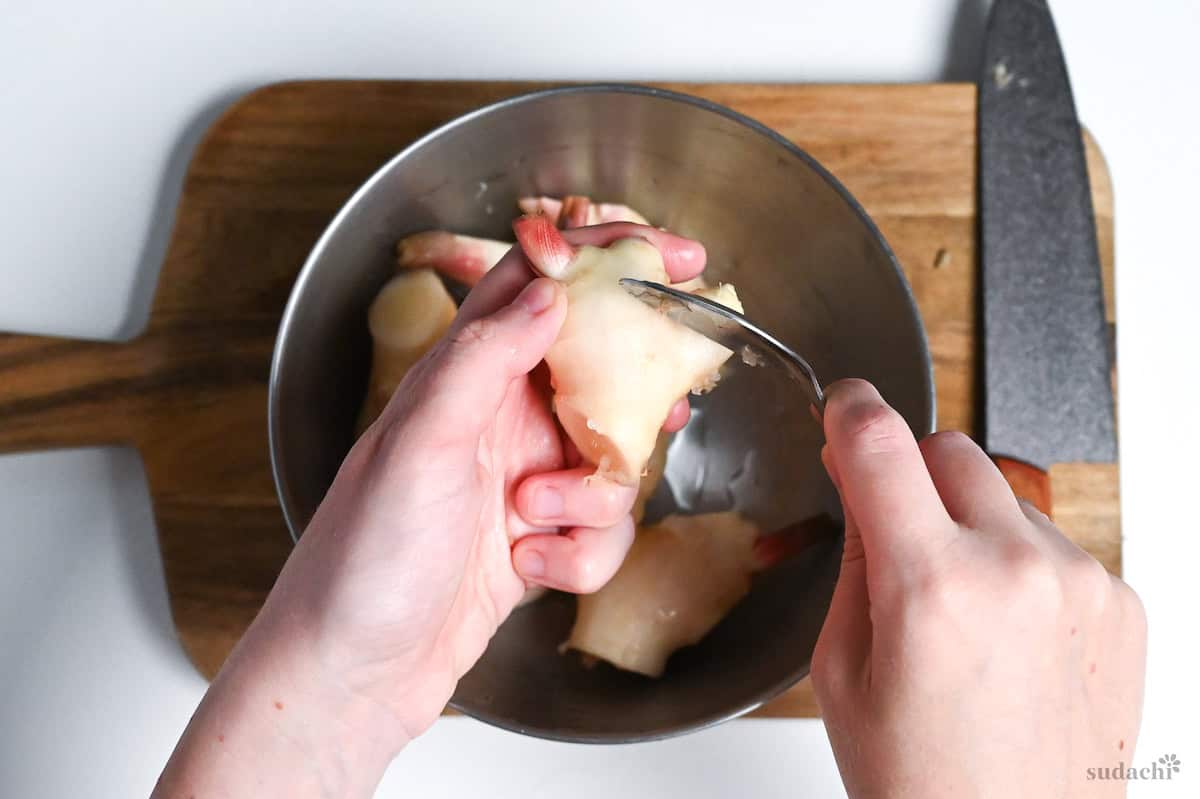
Young ginger has thin, tender skin and a milder bite compared to mature root ginger. Those pink-tinged stems aren’t just for show. They contain the natural pigments that give authentic gari its characteristic pale pink color.
Cut off the pink stem parts (or they can be intact if you prefer) and set them aside separately.
Then slice the ginger body into paper-thin pieces, about 1-2mm thick. I prefer using a sharp knife over a peeler because it gives me better control over the thickness, but either works.
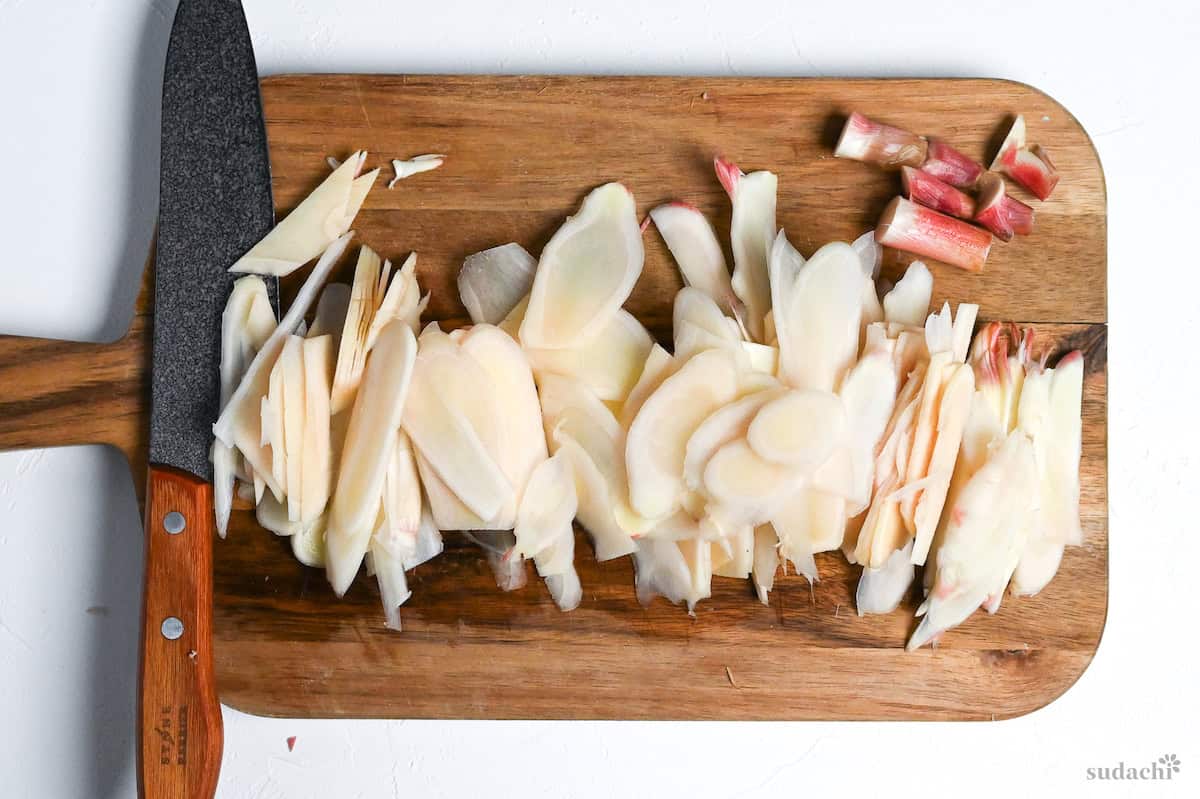
Don’t throw away those pink parts! Those reddish stem pieces are your secret to natural pink gari. They contain concentrated anthocyanin pigments that react with the vinegar’s acidity to create that beautiful color.
Bring a separate pot of water to a rolling boil. Add both the sliced ginger and the pink stem pieces, blanching for exactly 1 minute.

This brief heat treatment softens the ginger’s sharp bite and opens up its fibers to better absorb the pickling liquid.
One minute of blanching hits the sweet spot. Long enough to mellow the ginger’s heat and make it more receptive to the pickling liquid, but short enough to preserve its essential flavor compounds.
Go longer and you’ll start losing that characteristic ginger zing to the cooking water.
The ginger-infused liquid makes an excellent base for homemade ginger ale. Just add a touch of sugar, fresh lemon juice, and a pinch of cinnamon, then top with sparkling water for a refreshing bonus treat.
Drain the ginger in a colander and sprinkle lightly with salt.

Let it cool naturally! Resist the urge to shock it in ice water, which can strip away too much of the ginger’s natural heat along with excess moisture.
Once the ginger is cool enough to handle comfortably, squeeze out as much excess water as possible with your hands.

The salt you added earlier has been drawing out moisture and further mellowing the ginger’s intensity, creating the perfect canvas for the pickling liquid.
Remove the kombu from your cooled pickling liquid. Combine the squeezed ginger, those precious pink parts, and the pickling liquid in a clean, sterilized, lidded container. Make sure the ginger is completely submerged.

Cover tightly and refrigerate for at least 24 hours before your first taste. The ginger will continue to develop flavor and color for several days.

This recipe makes a large amount of sushi ginger. It keeps well, but if you don’t use it that often, you can cut the amount in half or a quarter and use a small jar or container for pickling.

Essential Tips & Tricks
- Choose young ginger with pink-tinged stems! This is your key to natural pink coloring.
- Don’t skip the blanching step! One minute in boiling water is crucial for mellowing the ginger’s bite.
- Salt lightly after blanching. This draws out excess moisture and further softens the ginger’s intensity.
- Squeeze out excess moisture gently after blanching and salting to ensure ginger absorbs the pickling liquid effectively.
- Wait the full 24 hours. The color and flavor develop gradually.
With these simple tips in mind, you’re set for success every time you make Sushi Ginger.
Storage Guide
Store your gari in clean, airtight glass containers in the refrigerator for 2-3 weeks, though it can last up to a month or longer when properly prepared.
The key is to keep the ginger completely submerged in the pickling liquid at all times. As you use the gari, just transfer the rest to smaller containers to keep the liquid coverage on point. And always use clean utensils when serving to prevent contamination.
The vinegar, sugar, and salt create an acidic environment (pH 2-3) that naturally preserves the ginger.
If you see any cloudiness, mold, or bad smells, toss it out. Some browning is normal.
FAQ
Here are answers to frequently asked questions I have received across all platforms, including here, YouTube, Instagram, and Pinterest. If you have any questions, feel free to send them to me anytime! It will be a big help for everyone in this community!
Aim for about 1-2mm thickness. Too thick and it stays tough and spicy, but too thin and you lose the satisfying crunch. If your slices ended up thicker, extend the pickling time to compensate.
You need those pink stem pieces from young ginger as they contain the pigments that create the color. Mature ginger won’t turn pink no matter how long you pickle it.
This usually means over-blanching or too much water rinsing, which strips away the ginger’s punch. Keep blanching brief and avoid excessive rinsing. If your pickling liquid is too sweet, add more vinegar to restore the balance.

I hope you enjoy this Sushi Ginger recipe! If you try it out, I’d really appreciate it if you could spare a moment to let me know what you thought by giving a review and star rating in the comments below. It’s also helpful to share any adjustments you made to the recipe with our other readers. Thank you!
More Japanese Pickles Recipes

Pickled Sushi Ginger (Homemade Gari)
Ingredients
- 250 ml water
- 125 ml rice vinegar or white vinegar
- 80 g light brown sugar swap to white sugar if you want a clearer pink hue
- 1 tsp Japanese light soy sauce (usukuchi shoyu) or regular soy + pinch salt
- 1 small piece dried kelp (kombu) about 5cm (2-inch) piece
- 340 g young ginger root (shin shoga) with pink stems
- 1 tsp salt
My recommended brands of ingredients and seasonings can be found in my Japanese pantry guide.
Can’t find certain Japanese ingredients? See my substitution guide here.
Instructions
- Take a saucepan and add 250 ml water, 125 ml rice vinegar, 80 g light brown sugar, 1 tsp Japanese light soy sauce (usukuchi shoyu) and 1 small piece dried kelp (kombu). Heat the mixture until almost boiling, then remove from the stove and leave to cool.

- Take 340 g young ginger root (shin shoga) and cut into 5cm pieces. Place the pieces in a bowl of water and gently clean the surface by rubbing it with your fingers. Cutting before cleaning will allow you to get into the crevices.

- Use the edges of a spoon to scrape off the outer skin and any discolored parts.

- Cut off the pink parts and set them aside for later. With a sharp knife, slice each piece of ginger as thinly as possible.

- Bring a pot of water to a rolling boil, then add the ginger slices (including the pink parts) and blanch for 1 minute.

- Drain in a colander and sprinkle with 1 tsp salt. Rest until cool enough to touch.

- Once cooled, squeeze out the excess liquid.

- When the pickling liquid is cool, transfer it to a sealable container and remove the kombu. Add the blanched ginger. Don't forget to add the pink parts as these will add color to your gari.

- Cover and rest in the refrigerator for at least 24 hours.

- Enjoy!

Video
Notes
- Pick firm young ginger with pink tips and skip wrinkled or moldy roots to avoid bitter off-flavors.
- Sterilize jars and lids in boiling water for 5 minutes, then air-dry.
- Store in airtight containers in the refrigerator for up to 3 weeks, though proper storage can extend this longer. After 3 weeks, smell before eating and discard if there’s any off odor.
- Serving ideas: Inarizushi, Temari Sushi, Temaki Sushi, Tekka Don
- Note: The nutritional information includes the pickling liquid.
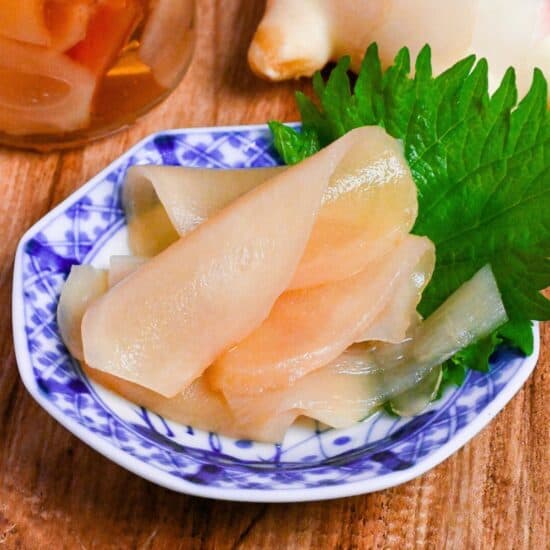




Leave a rating and a comment